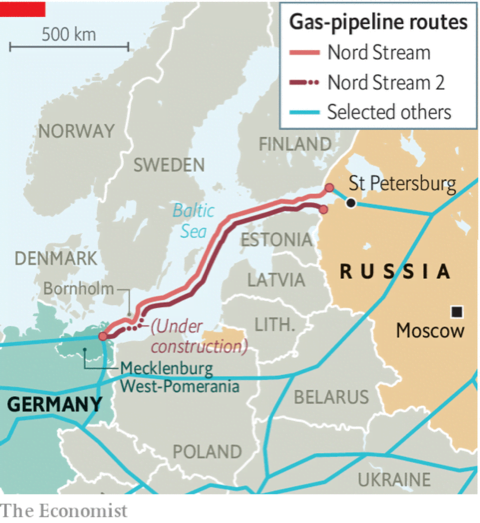[ad_1]
INTERNATIONAL/ ECONOMY
Topic:
- GS-2: Policies and Politics of developed and developing countries
Nord Stream 2 pipeline
Context: The US, which had previously imposed sanctions to prevent the completion of a major new gas pipeline between Russia and Germany, has now signalled its approval for the project.

Source: The Economist
What is the Nord Stream 2 pipeline?
- In 2015, the Russian energy major Gazprom and five other European firms decided to build Nord Stream 2, valued at around $11 billion.
- The 1,200-km pipeline will run from Russia to Germany through the Baltic Sea, and will carry 55 billion cubic metres of gas per year.
- The under-construction pipeline will run along with the already completed Nord Stream 1 system, and the two together will supply an aggregate of 110 billion cubic metres of gas to Germany per year.
- Nord Stream 2 pipeline falls in the territory of EU members Germany and Denmark, and is about 98% complete (see figure)
So, why is the pipeline controversial?
- Since it was first planned, Nord Stream 2 has drawn criticism from the US, as it believes that the project would increase Europe’s dependence on Russia for natural gas. Currently, EU countries already rely on Russia for 40 per cent of their gas needs.
- Former US President Donald Trump had stated that the project could turn Germany into a “hostage of Russia”.
- Thus dependence of EU on Russia is going to increase which emboldens Russian leader Vladimir Putin.
- The project also has opponents in eastern Europe, especially Ukraine, whose ties with Russia have seriously deteriorated in the aftermath of the Crimean conflict in 2014
- Ukraine feels that once Nord Storm 2 is completed, Russia could bypass the existing Ukrainian pipeline (connecting Russia & Europe), and deprive it of lucrative transit fees of around $3 billion per year.
- Ukraine also fears another invasion by Russia once the new pipeline is operational.
- On the other hand, Germany has solidly stood behind the completion of Nord Stream 2, despite opposition from allies like US, with the German government insisting that it is a commercially beneficial project.
And, why has the US position changed?
- In December 2019, work on the project was suspended due to the threat of US sanctions, and in January 2021, US actually carried out its threat– imposing sanctions on a Russian ship tasked with laying pipes for the project.
- Many had then predicted that the punitive action could prove to be the pipeline’s death knell.
- In a shift from former US President Trump’s approach, Joe Biden (current US President) has gone with the softer option of threatening Russia with consequences should it use the pipeline to harm Ukraine or other countries in eastern Europe.
- The US-Germany deal lays out that if Russia attempts to use energy as a political weapon or commit further aggressive acts against Ukraine, then Germany will undertake actions, including sanctions, against Russia
- The agreement also requires Germany to “utilise all available leverage” to extend by 10 years the current Russia-Ukraine gas transit agreement, which expires in 2024.
- Germany should contribute at least $175 million to a new $1 billion “Green Fund for Ukraine” that aims at improving the country’s energy independence.
What has the reaction been?
- Opposition in the USA has denounced the agreement as a generational geopolitical win for Putin and a catastrophe for the United States and allies.
- Critics argue that the deal empowers Russia to spread its malign influence throughout Eastern Europe.
- Ukraine is also unhappy and wants a “frank and vibrant” discussion with USA.
Connecting the dots:
[ad_2]


